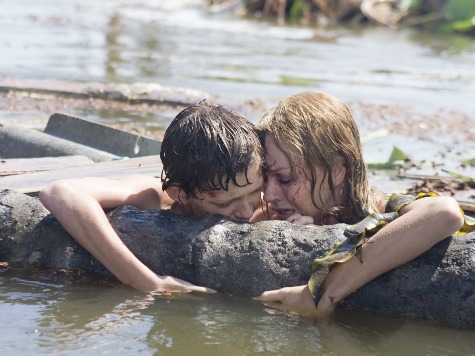One of the largest earthquakes in history rattled the entire planet at the end of 2004, generating a tsunami that immersed Southern Asia under water, killing up to 300,000 people and displacing 10 million others.
And yet, in the ensuing years, surprisingly few works of art have been dedicated to exploring it.
A wonderful exception is The Impossible, staring Naomi Watts and Ewan McGregor. This movie, out April 23 on Blu-ray, portrays the true story of a heroic couple and their three children who were vacationing in Thailand when a killer wave crashed down and separated them.
Watts gives a restrained but powerful performance as the mother fighting through rough waters to save her own life while desperately searching for the rest of her family. It is a role which earned her a 2013 Academy Award nomination for Best Actress, and justifiably so.
The true star of The Impossible, however, is Tom Holland, who plays Watt’s 13 year-old son, Lucas. This role must have been extremely demanding for any young, inexperienced actor, and Holland’s portrayal of Lucas helps the movie find a deeper meaning beneath the surface story itself: the premature coming of age that children can experience in desperate situations.
In one particularly striking scene Lucas helps his mother climb a tree to safety. He demands that she step on his shoulders since she is badly hurt and too weak to pull herself up. His willingness to endure the immense pressure and pain as he struggles to support his mother demonstrates his intent to take on the role of the protector.
Throughout the rest of the film, Lucas continues to look after his mother, bringing her water and dealing with doctors on her behalf, displaying courage beyond his years.
A similar theme is explored in another disaster movie, last year’s Beasts of the Southern Wild. This film, which was nominated for multiple Oscars this past year as well, explores the life of six year-old girl named Hushpuppy, played by Quvenzhane Wallis. Hushpuppy lives with her father on a Louisiana bayou, a small, isolated island whose inhabitants have no interaction with the New Orleans mainlanders and view the modern world as “a fish tank with no water.”
When a hurricane hits, however, Hushpuppy is yanked out of her childhood and not only learns about the difficulties in life as she cares for her ill father, but is forced to confront and overcome them.
Wallis paints a portrait of bravery and determination that belies her innocent and inquisitive gaze. Wallis’s portrayal of Hushpuppy received much deserved critical acclaim and the actress competed against Watts for an Academy Award, making her the youngest ever Best Actress nominee.
Though both The Impossible and Beasts of the Southern Wild explore similar themes, there are also important differences. The Impossible stars Watts and McGregor, two acclaimed actors. Though both are excellent in their respective roles, the audience’s familiarity with their faces is distracting and one could half expect King Kong to come swoop Watts out of the water.
On the other hand, Beasts’ cast consists of unknown faces and stars two individuals who had never even acted before. This unfamiliarity helps bring us into a world that feels real and dangerous, even though that world is filtered through the vivid imagination of the child protagonist.
Of the two films, Beasts of the Southern Wild is a more successful character study. Whereas The Impossible is packed with nail-biting action and splits its focus between different family members, Beasts is concerned entirely with one character and her father.Most amazing about Wallis’s performance is how she conveys a mix of strength and fear in subtle, nonverbal ways. She does not overact or over emote. Although her face remains composed, she conveys insecurity and sadness through eyes that are as dark and deep as the waters that washed away her childhood.
How is it possible that these independent films, about difficult subjects and produced without the benefit of big studio money, received the industry’s highest recognition? Though many may not have seen them, the secret to their success is that those who did watch them were deeply moved. As Tom Holland explained in an interview, the aim of The Impossible was not “to create a typical blockbuster. We wanted to create a true story that affects everyone.”
And indeed like a flood affects both psyche and geography long after the waters recede, these movies leave the audience with turmoil of emotions that persists even after the credits roll.These movies fill us with sadness, but also leave us with a glimmer of hope–hope that family can be a source of salvation even in our darkest times.

COMMENTS
Please let us know if you're having issues with commenting.